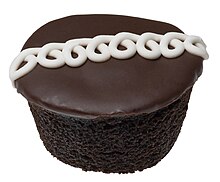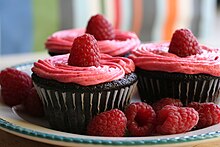Contents |
History
The first mention of the cupcake can be traced as far back as 1796, when a recipe notation of "a cake to be baked in small cups" was written in American Cookery by Amelia Simmons.[1] The earliest documentation of the term cupcake was in “Seventy-five Receipts for Pastry, Cakes, and Sweetmeats” in 1828 in Eliza Leslie's Receipts cookbook.[2]In the early 19th century, there were two different uses for the name cup cake or cupcake. In previous centuries, before muffin tins were widely available, the cakes were often baked in individual pottery cups, ramekins, or molds and took their name from the cups they were baked in. This is the use of the name that has remained, and the name of "cupcake" is now given to any small cake that is about the size of a teacup. The name "fairy cake" is a fanciful description of its size, which would be appropriate for a party of diminutive fairies to share. While English fairy cakes vary in size more than American cupcakes, they are traditionally smaller and are rarely topped with elaborate icing.
The other kind of "cup cake" referred to a cake whose ingredients were measured by volume, using a standard-sized cup, instead of being weighed. Recipes whose ingredients were measured using a standard-sized cup could also be baked in cups; however, they were more commonly baked in tins as layers or loaves. In later years, when the use of volume measurements was firmly established in home kitchens, these recipes became known as 1234 cakes or quarter cakes, so called because they are made up of four ingredients: one cup of butter, two cups of sugar, three cups of flour, and four eggs.[3][4] They are plain yellow cakes, somewhat less rich and less expensive than pound cake, due to using about half as much butter and eggs compared to pound cake. The names of these two major classes of cakes were intended to signal the method to the baker; "cup cake" uses a volume measurement, and "pound cake" uses a weight measurement.[3]
In the early 21st century, a trend for cupcake shops was reported in the United States, playing off of the sense of nostalgia evoked by the cakes. In New York City, cupcake shops like Magnolia Bakery gained publicity in their appearances on popular television shows like HBO's Sex and the City. In 2010, television presenter Martha Stewart published a cook book dedicated to cupcakes.[5]
Cupcakes have become more than a trend over the years; they've become an industry. Rachel Kramer Bussel, who has been blogging about cupcakes since 2004 at Cupcakes Take the Cake, said in 2010 that "in the last two years or so, cupcakes really exploded" with more cupcake-centric bakeries opening nationwide. [6]
Cupcake recipes
A standard cupcake uses the same basic ingredients as standard-sized cakes: butter, sugar, eggs, and flour. Nearly any recipe that is suitable for a layer cake can be used to bake cupcakes. The cake batter used for cupcakes may be flavored or have other ingredients stirred in, such as raisins, berries, nuts, or chocolate chips.Because their small size is more efficient for heat conduction, cupcakes bake much faster than a normal layered cake.
Cupcakes may be topped with frosting or other cake decorations. They may be filled with frosting or pastry cream. For bakers making a small number of filled cupcakes, this is usually accomplished by using a spoon or knife to scoop a small hole in the top of the cupcake. In commercial bakeries, the filling may be injected using a syringe.
Variants
- A "cake in a mug" is a variant that gained popularity on many internet cooking forums and mailing lists. The technique uses a mug as its cooking vessel and can be done in a microwave oven. The recipe often takes fewer than five minutes to prepare.
- A butterfly cake is a variant of cupcake,[7][8][9][10] also called fairy cake for its fairy-like "wings".[11] They can be made from any flavor of cake. The top of the fairy cake is cut off or carved out with a spoon, and cut in half. Then, butter cream, whipped cream or other sweet filling (e.g. jam) is spread into the hole. Finally, the two cut halves are stuck into the butter cream to look like butterfly wings. The wings of the cake are often decorated using icing to form various patterns.
- A cake ball is an individual portion of cake, round like a chocolate truffle, that is coated in chocolate.[12] These are typically formed from crumbled cake mixed with frosting, rather than being baked as a sphere.
- A gourmet cupcake is a somewhat recent variant of cupcake. Gourmet cupcakes are large and filled cupcakes, based around a variety of flavor themes, such as Tiramisu or Cappuccino. In recent years there has been an upcropping of stores that sell only gourmet cupcakes in metropolitan areas, such as Crumbs Bake Shop.[11]
- As an alternative to a plate of individual cakes, some bakers place standard cupcakes into a pattern and frost them to create a large design, such as a basket of flowers or a turtle.[13]
Pans and liners
Originally, cupcakes were baked in heavy pottery cups. Some bakers still use individual ramekins, small coffee mugs, large tea cups, or other small ovenproof pottery-type dishes for baking cupcakes.Cupcakes are usually baked in muffin tins. These pans are most often made from metal, with or without a non-stick surface, and generally have six or twelve depressions or "cups". They may also be made from stoneware, silicone rubber, or other materials. A standard size cup is 3 inches (76 mm) in diameter and holds about 4 ounces (110 g), although pans for both miniature and jumbo size cupcakes exist.[14] Speciality pans may offer many different sizes and shapes.

Cupcakes may be plain cakes without any frosting or other decoration. These were baked on a flat baking sheet in a double-layer of paper cupcake liners.
In addition to paper, cupcake liners may be made from very thin aluminum foil or, in a non-disposable version, silicone rubber. Because they can stand up on their own, foil and silicone liners can also be used on a flat baking sheet, which makes them popular among people who do not have a specialized muffin tin. Some of the largest paper liners are not fluted and are made out of thicker paper, often rolled at the top edge for additional strength, so that they can also stand independently for baking without a cupcake tin. Some bakers use two or three thin paper liners, nested together, to simulate the strength of a single foil cup.
Major retailers and manufacturers of cupcake cases include:
See also
- Petits fours, individual-sized or bite-sized cakes made by cutting a large sheet cake and frosting the pieces
- Muffins, cupcake sized quickbreads
- Tea cake, a broad class of breads and cakes served with tea
- Cupcake Wars, a reality TV series in the United States
Notes and references
- ^ "The Food Timeline". Lynne Olver. http://www.foodtimeline.org/foodcakes.html#cupcakes.
- ^ "Food Timeline". http://www.crazyaboutcupcakes.com/learning.htm#history. Retrieved 5 April 2010.
- ^ a b "The Food Timeline: cake history notes". http://www.foodtimeline.org/foodcakes.html#1234cake. Retrieved 14 March 2008.
- ^ Cupcakes - Food Timeline
- ^ "Cupcake Passion More Than a Trend". CNN. 15 January 2010. http://articles.cnn.com/2010-03-23/living/cupcake.craze_1_cupcake-craze-classroom-birthday-parties-chocolate?_s=PM:LIVING. Retrieved 27 October 2010.
- ^ Bonisteel, Sara. "Cupcake passion more than a trend". CNN. http://articles.cnn.com/2010-03-23/living/cupcake.craze_1_cupcake-craze-classroom-birthday-parties-chocolate?_s=PM:LIVING. Retrieved 23 September 2011.
- ^ Farrow, Joanna (2005). Cupcakes. Vancouver: Whitecap Books. pp. 40–41. ISBN 1-55285-626-7.
- ^ Mackley, Lesley (1992). The Book of Afternoon Tea. Los Angeles: HP Books. p. 69. ISBN 1-55788-046-8.
- ^ Moskin, Julia; Gand, Gale (2001). Gale Gand's just a bite: 125 luscious little desserts. New York: Clarkson Potter. pp. 68–69. ISBN 0-609-60825-8.
- ^ Byrn, Anne (2005). Cupcakes: From the Cake Mix Doctor. Workman Publishing. pp. 98–100. ISBN 0-7611-3548-0.
- ^ a b Klivans, Elinor (2005). Cupcakes. San Francisco: Chronicle Books. pp. 80–81. ISBN 0-8118-4545-1.
- ^ "Cool Cakes for 2010" by Simone Sant-Ghuran (7 Feb 2010) at The Guardian Trinidad and Tobago[dead link]
- ^ See, for example, this recipe for a turtle-shaped cake made from cupcakes, or these photos.
- ^ a b "The Joy of Baking". http://www.joyofbaking.com/muffins/muffins.html. Scroll down the page to section labeled "PANS".




Tidak ada komentar:
Posting Komentar